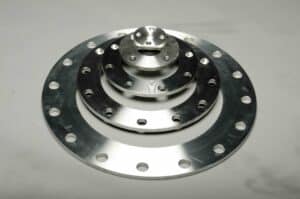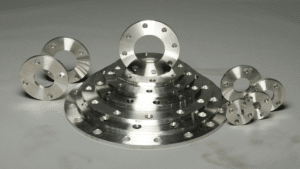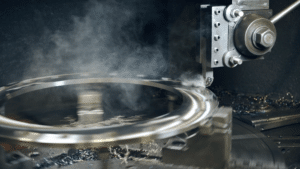Flanges are manufactured using three main techniques: casting, cutting from rolled plate material, or forging. No matter the technique, the basic flange production includes processing raw materials, then forming them to the appropriate specifications. Flanges are finished to meet the applicable standards for fit and seal, then flanges are packaged and shipped to the customer. Here, we explain the three most common flange manufacturing techniques and compare the pros and cons of each method.
Raw Materials for Flange Manufacturing
The flange manufacturing process begins with top-quality raw materials from various sources which may fall under several classifications, such as Domestic, Buy America, or Imported. Raw materials may be domestically produced or sourced from countries including China, India, and South Korea.
These raw materials undergo a rigorous testing and approval process prior to purchase by the manufacturer. The resulting Mill Test Report (MTR) declares the chemical and physical properties and verifies that the materials meet the minimum requirements set forth by the applicable standards. The manufacturer refers to the MTR produced during testing to verify quality before manufacturing begins.
The most common raw materials used in flange production are:
- Mild/Carbon Steel
- Stainless Steel
- Ductile Iron
- Aluminum
Common Flange Manufacturing Methods
Flanges are manufactured by shaping, then machining, drilling, and finishing to the proper specifications. There are a variety of ways flanges are made, including cast, cut, and forged manufacturing methods.
Cast Flange Production Method
The cast manufacturing method begins with molten metal that’s poured into a mold to form the desired shape—in this case, a flange. After the liquid metal has hardened, the mold is opened and the casting is removed, then machined to the necessary dimensions and surface finish. Flanges produced by casting cost less to produce, and there is less waste involved in the manufacturing process. However, there may be more defects than forged flanges due to the less compact internal structure. As a result, cast flanges may be more prone to failure in high pressure or temperature applications.
Cut Flange Production Method
The cut flange (or plate flange) manufacturing process begins by flattening steel metal stock using rollers to thin the material until it reaches the intended plate thickness. Then, the flange is cut to the appropriate Outer Diameter (OD) and Inner Diameter (ID) (except blind flanges which have no center bore and do not require an ID) using a torch, laser, or water jet.
Bolt holes and necessary serrations are cut, and the flange is further machined to exact specifications. Flanges produced using the cut manufacturing method offer a lower production cost, but more scrap materials waste. Cut flanges are typically not as strong as flanges produced using other manufacturing techniques.
Forged Flange Production Method
Forged flanges are manufactured by heating steel billets, slabs, or other metal stock, then compressing the material using a power hammer, press, or die to shape the flange from a solid state. This process develops a continuous grain flow for improved strength. After the flange is forged, it is machined and finished to the appropriate specifications. Forged flanges are often more resistant to wear, but the production cost is greater.
Comparison of Flange Manufacturing Methods
Each flange production technique has pros and cons. When choosing flanges, opt for products that have been manufactured to meet the specifications of the intended application. This includes temperature-pressure ratings as well as the chemical composition and final dimensions of the flange. How flanges are made may affect some or all of these requirements, so consider each manufacturing method’s advantages and disadvantages.
| Cast | Plate/Cut | Forged | |
| Cost | Better | Best | Good |
| Strength | Better | Good | Best |
| Tolerances | Best | Better | Good |
| Limiting Material Waste | Better | Good | Best |
| Variety of Material & Sizes | Best | Good | Better |
Flange Surface Finishings and Coatings
The flange finish—the roughness or smoothness as well as type of serrations—is completed after the flange is cast, forged, or cut. Flange finish requirements vary based on the selected standard and application. Flange finish options include continuous and concentric serrated, smooth, mill or rolled, and machined finish. We offer modifications to stock items and custom machining so you can get the exact product you need for every application. Protective coatings are applied prior to packaging and shipment.
Flange production techniques, including cast, cut, or forged, can affect the overall performance of the flange. To determine the appropriate technique, consider your intended application and refer to any relevant piping standards. For more information about flange types, materials, and requirements, browse our Resource Center or contact one of our sales staff to discuss.





